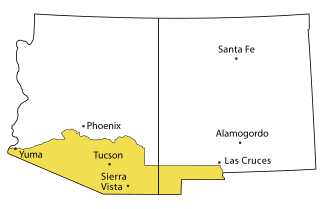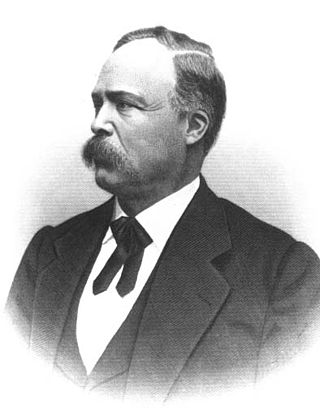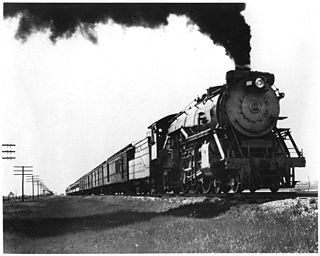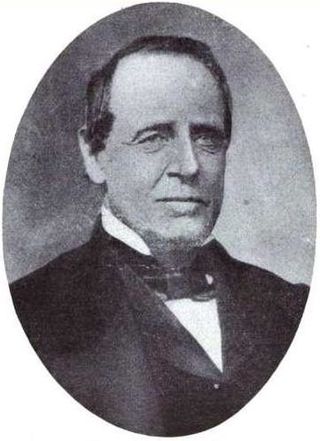Related Research Articles

The Central Pacific Railroad (CPRR) was a rail company chartered by U.S. Congress in 1862 to build a railroad eastwards from Sacramento, California, to complete the western part of the "First transcontinental railroad" in North America. Incorporated in 1861, CPRR ceased operation in 1959 when assets were formally merged into the Southern Pacific Railroad.

America's first transcontinental railroad was a 1,911-mile (3,075 km) continuous railroad line constructed between 1863 and 1869 that connected the existing eastern U.S. rail network at Council Bluffs, Iowa, with the Pacific coast at the Oakland Long Wharf on San Francisco Bay. The rail line was built by three private companies over public lands provided by extensive US land grants. Building was financed by both state and US government subsidy bonds as well as by company-issued mortgage bonds. The Western Pacific Railroad Company built 132 miles (212 km) of track from the road's western terminus at Alameda/Oakland to Sacramento, California. The Central Pacific Railroad Company of California (CPRR) constructed 690 miles (1,110 km) east from Sacramento to Promontory Summit, Utah Territory. The Union Pacific Railroad (UPRR) built 1,085 miles (1,746 km) from the road's eastern terminus at the Missouri River settlements of Council Bluffs and Omaha, Nebraska, westward to Promontory Summit.

A transcontinental railroad or transcontinental railway is contiguous railroad trackage, that crosses a continental land mass and has terminals at different oceans or continental borders. Such networks can be via the tracks of either a single railroad or over those owned or controlled by multiple railway companies along a continuous route. Although Europe is crisscrossed by railways, the railroads within Europe are usually not considered transcontinental, with the possible exception of the historic Orient Express. Transcontinental railroads helped open up unpopulated interior regions of continents to exploration and settlement that would not otherwise have been feasible. In many cases they also formed the backbones of cross-country passenger and freight transportation networks. Many of them continue to have an important role in freight transportation and some like the Trans-Siberian Railway even have passenger trains going from one end to the other.

The Gadsden Purchase is a 29,640-square-mile (76,800 km2) region of present-day southern Arizona and southwestern New Mexico that the United States acquired from Mexico by the Treaty of Mesilla, which took effect on June 8, 1854. The purchase included lands south of the Gila River and west of the Rio Grande where the U.S. wanted to build a transcontinental railroad along a deep southern route, which the Southern Pacific Railroad later completed in 1881–1883. The purchase also aimed to resolve other border issues.
The Pacific Railroad Acts of 1862 were a series of acts of Congress that promoted the construction of a "transcontinental railroad" in the United States through authorizing the issuance of government bonds and the grants of land to railroad companies. In 1853, the War Department under then Secretary of War Jefferson Davis was authorized by the Congress to conduct surveys of five different potential transcontinental routes from the Mississippi ranging from north to south. It submitted a massive twelve volume report to Congress with the results in early 1855. However, no route or bill could be agreed upon and passed authorizing the Government's financial support and land grants until the secession of the southern states in 1861 removed their opposition to a central route. The Pacific Railroad Act of 1862 was the original act. Some of its provisions were subsequently modified, expanded, or repealed by four additional amending Acts: The Pacific Railroad Act of 1863, Pacific Railroad Act of 1864, Pacific Railroad Act of 1865, and Pacific Railroad Act of 1866.

James Gadsden was an American diplomat, soldier and businessman after whom the Gadsden Purchase is named, pertaining to land which the United States bought from Mexico, and which became the southern portions of Arizona and New Mexico. James Gadsden served as Adjutant General of the U.S. Army from August 13, 1821 – March 22, 1822. Between 1853 and 1856, he served as U.S. Minister to Mexico. He was known commonly as General Gadsden, although he never had a rank above colonel.
A land grant is a gift of real estate—land or its use privileges—made by a government or other authority as an incentive, means of enabling works, or as a reward for services to an individual, especially in return for military service. Grants of land are also awarded to individuals and companies as incentives to develop unused land in relatively unpopulated countries; the process of awarding land grants are not limited to the countries named below. The United States historically gave out numerous land grants as Homesteads to individuals desiring to prove a farm. The American Industrial Revolution was guided by many supportive acts of legislatures promoting commerce or transportation infrastructure development by private companies, such as the Cumberland Road turnpike, the Lehigh Canal, the Schuylkill Canal and the many railroads that tied the young United States together.
The Denver Pacific Railway was a historic railroad that operated in the western United States during the late 19th century. Formed in 1867 in the Colorado Territory, the company operated lines in Colorado and present-day southeastern Wyoming in the 1870s until merging with the Kansas Pacific and Union Pacific railroads in 1880. The railroad was formed primarily to create a link between Denver and the transcontinental railroad at Cheyenne, an achievement that was widely credited at the time with making Denver the dominant metropolis of the region.
The Kansas Pacific Railway (KP) was a historic railroad company that operated in the western United States in the late 19th century. It was a federally chartered railroad, backed with government land grants. At a time when the first transcontinental railroad was being constructed by the Central Pacific and the Union Pacific, it tried and failed to join the transcontinental ranks. It was originally the "Union Pacific, Eastern Division", although it was completely independent. The Pennsylvania Railroad, working with Missouri financiers, designed it as a feeder line to the transcontinental system. The owners lobbied heavily in Washington for money to build a railroad from Kansas City to Colorado, and then to California. It failed to get funding to go west of Colorado. It operated many of the first long-distance lines in the state of Kansas in the 1870s, extending the national railway network westward across that state and into Colorado. Its main line furnished a principal transportation route that opened up settlement of the central Great Plains, and its link from Kansas City to Denver provided the last link in the coast-to-coast railway network in 1870. The railroad was consolidated with the Union Pacific in 1880, and its mainline continues to be an integral part of the Union Pacific network today.

Miguel Antonio Otero was a prominent American politician of the New Mexico Territory and instrumental in the economic development of the territory.

The Texas and Pacific Railway Company was created by federal charter in 1871 with the purpose of building a southern transcontinental railroad between Marshall, Texas, and San Diego, California.

The Fort Worth and Denver Railway, nicknamed "the Denver Road", was a class I American railroad company that operated in the northern part of Texas from 1881 to 1982, and had a profound influence on the early settlement and economic development of the region.

Henry Connelly was Governor of the New Mexico Territory during the American Civil War. He was appointed by President Lincoln and served from September 4, 1861, until July 6, 1866. During his term, the territory broke into two, and then three parts due to the Civil War and administrative problems.

Thomas Clark Durant was an American physician, businessman, and financier. He was vice-president of the Union Pacific Railroad (UP) in 1869 when it met with the Central Pacific railroad at Promontory Summit in Utah Territory. He created the financial structure that led to the Crédit Mobilier scandal. He was interested in hotels in the Adirondacks and once owned the yacht Idler.

The Alabama Great Southern Railroad is a railroad in the U.S. states of Alabama, Georgia, Louisiana, Mississippi, and Tennessee. It is an operating subsidiary of the Norfolk Southern Corporation (NS), running southwest from Chattanooga to New Orleans through Birmingham and Meridian. The AGS also owns about a 30% interest in the Kansas City Southern-controlled Meridian-Shreveport Meridian Speedway.
The Western Pacific Railroad (1862–1870) was formed in 1862 to build a railroad from Sacramento, California, to the San Francisco Bay, the westernmost portion of the First transcontinental railroad. After the completion of the railroad from Sacramento to Alameda Terminal on September 6, 1869, and then the Oakland Pier on November 8, 1869, which was the Pacific coast terminus of the transcontinental railroad, the Western Pacific Railroad was absorbed in 1870 into the Central Pacific Railroad.
The 4th Arizona Territorial Legislative Assembly was a session of the Arizona Territorial Legislature which ran from September 4, 1867, till October 7, 1867, in Prescott, Arizona. Among the sessions accomplishments were establishment of the territory's first "permanent" capital and creation of the territory's first school district.
The article of incorporation for the New Mexico Wool Manufacturing Company was introduced and passed in the New Mexico Territorial Legislature on January 30, 1861. Its founding associates were Ceran St. Vrain, José Guadalupe Gallegos, Oliver P. Hovey, Anastacio Sandoval, Rafael Armijo, José Manuel Gallegos, Hamilton G. Fant, Nazario Gonzales, J. Francisco Chaves; Levi Spiegelberg, A.P. Wilbar, Miguel A. Otero, William W. Griffin; José Leandro Perea ; S. J. Spiegelberg, Tomás Cabeza de Baca, Sidney A. Hubbell, Francisco Lopez, William A. Street, Ramon Luna; Miguel E. Pino, who became commander of 2nd New Mexico Volunteer Infantry during the Civil War; Thomas H. Hopkins; Simon Delgado who, with his mother, Doña Maria de la Luy Baca de Delgado, purchased the Yglesia Castrense in Santa Fe from Bishop Lamy in exchange for $1,000 and a portion of the site for St. Michael's College in Santa Fe; M. Steck, Vicente García, Teodoro Baca, Vicente Romero, José Jaramillo, and Manuel Vigil. They claimed lawful use, occupation, and right to construct roads and erect buildings on, any wild lands within the Territory not the property of other individuals or corporations. They also claimed lawful use of water and the right to construct machinery on any river or stream upon said lands. The statement of capital stock was 3,500 shares at $100 each, or $350,000, with the right to increase the number of total shares to 7,500 at a value of $750,000.
The Winona and St. Peter Railroad was a railroad in the Midwestern United States. It was founded in 1861 in Winona, Minnesota. The first 11 miles (18 km) from Winona to Stockton, Minnesota, were completed by the end of 1862, making the it the second operational railroad in Minnesota, after the St. Paul and Pacific Line from Saint Paul to St. Anthony Falls.
The Montezuma Copper Mining Company of Santa Fé, New Mexico was incorporated (1861) in the American Territory of New Mexico for the purpose of mining precious metals, industrial metals, and coal in the counties of Santa Ana, Santa Fé, San Miguel, and Rio Arriba.
References
- ↑ Allison, W.H.H. "Colonel Francisco Perea". Old Santa Fe: a Magazine of History, Archaeology, Genealogy and Biography, Vol.1, ed. Ralph Emerson Twitchell. Old Santa Fe Press, 1914. p. 213. Retrieved 16 December 2011.
- ↑ Hovey, O.P. (printer). Laws passed by the General Assembly of the Territory of New Mexico Passed by the Legislative Assembly, Session 1859-60. State of New Mexico, 1860. Retrieved 12 December 2011. p.110
- ↑ Ford, Thomas H. (printer). Memorial of the New Mexico Railway Company in Relation of the Pacific Railroad. U.S. House of Representatives, 1st Session, 36th Congress, 1859-'60. Retrieved 12 December 2011. p.437